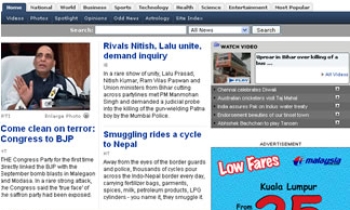The stratospheric increase in the use of online classified advertising – up 80 percent year over year according to a just-released study in the United States (US) – represents a coming of age for the Web, a milestone that will continue to eclipse itself for the foreseeable future, says one of the Internet's most popular classified ad companies.
"This kind of precipitous growth within a 12-month period suggests that consumers have become quite comfortable with the technology, with the security and with the culture of the Internet," says Conrad M Hall, president of Trader Publishing Company, whose family of classified sites ranks second only to Craigslist in unique site visitors. "I think the increasing availability of broadband and the ever-widening array of online products and services will continue to propel more and more buyers to turn to the Web to find what they are looking for."
Trader Publishing has witnessed the acceleration in Web traffic first hand. According to a study released this week by the Pew Internet & American Life Project and comScore Networks, Trader's 40 Internet sites – including ForRent.com, Homes.com and TraderOnline.com – received 8.2 million unique visitors in September this year, up 90 per cent from the previous September.
According to Peter Ill, vice president, Trader Electronic Media, the dramatic upsurge in hits to Trader classified ad sites over the past year is due not only to consumers' increased use of the Web generally, but also to the fact that the company has acquired or launched a dozen new sites, including the popular Homes.com (1.3 million unique visitors in September 05), AutoMart.com (896,000) and AutoExtra.com (824,000).
Ill says that the newly released data from Pew and comScore validates a strategy that began close to 10 years ago when the company began its transition from the page to the mouse.
"The launch of Traderonline.com in early 1996 was our initial step toward an aggressive embrace of the Internet," he says. "A decade later, while we are among the most visited classified ad sites on the Web, we really have dipped just a toe in the water. After all, only about 22 per cent of the 169 million Americans on the Internet have used online classifieds, which leads us to believe that we will continue to see robust growth in our Web-based offerings."
Hall says that Trader is just as upbeat about its 750 free and paid publications. The company's published classified ad magazines – such as Auto Trader, Harmon Homes and The Employment Guide – have a robust total weekly circulation of nearly nine million.
"Print classifieds remain a critical component of our overall strategy," Hall says, "and we always have regarded the Internet as a means for expanding our reach to larger and more focused audiences. Our approach has been to leverage our family of familiar print brands to the Web, and I think that the Pew numbers point to a strategy that is clearly paying off, arguably better than just about any other company. We are a new kind of media company, and we will continue to reach an increasingly sophisticated consumer through a combination of online and print media."
In total, Trader – through its published and online outlets – includes more than 10 million listings, helping tens of thousands of businesses connect to millions of consumers.
"If you look at the nature of these classified listings – for homes and apartments, jobs and vehicles – they represent significant events in the lives of consumers," Hall says. "Trader is a valued and trusted portal designed to help people make the most of those decisions. That is ultimately the essence of the Trader brand."
The Pew Internet Project findings come from a nationally representative telephone survey of 2,251 American adults (age 18 and older), including 1,577 internet users, between September 13 and October 14, 2005. The margin of error on the internet user portion of the survey is plus or minus 3 per cent.
The comScore data cited in the report come from comScore Media Metrix, an internet audience measurement service that uses a massive cross-section of more than 1.5 million US consumers who have given comScore explicit permission to confidentially capture their browsing and transaction behaviour, including online and offline purchasing.









